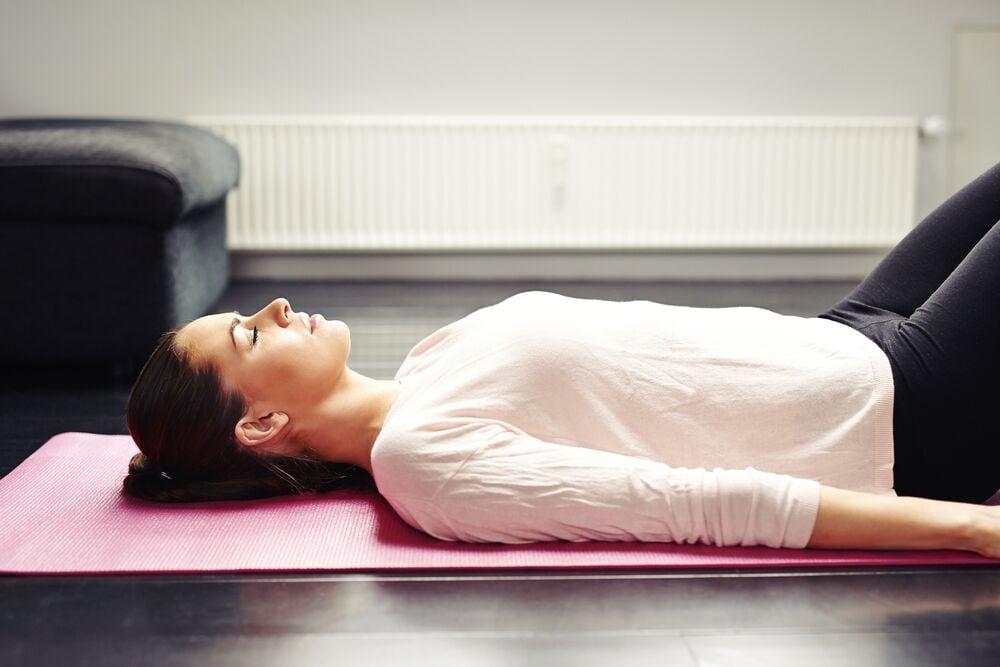After sharing your body with a tiny — yet demanding — person for the better part of a year, you may be itching to feel like yourself again. If you’ve experienced an uncomplicated vaginal delivery, you may be able to start exercising even sooner than you’d expect.
-
Tracking cycle
-
Getting pregnant
-
Pregnancy
-
Help Center
-
Flo for Partners
-
Anonymous Mode
-
Flo app reviews
-
Flo Premium New
-
Secret Chats New
-
Symptom Checker New
-
Your cycle
-
Health 360°
-
Getting pregnant
-
Pregnancy
-
Being a mom
-
LGBTQ+
-
Quizzes
-
Ovulation calculator
-
hCG calculator
-
Pregnancy test calculator
-
Menstrual cycle calculator
-
Period calculator
-
Implantation calculator
-
Pregnancy weeks to months calculator
-
Pregnancy due date calculator
-
IVF and FET due date calculator
-
Due date calculator by ultrasound
-
Medical Affairs
-
Science & Research
-
Pass It On Project New
-
Privacy Portal
-
Press Center
-
Flo Accuracy
-
Careers
-
Contact Us
5 Exercises to Reconnect with Your Body After Vaginal Delivery


Every piece of content at Flo Health adheres to the highest editorial standards for language, style, and medical accuracy. To learn what we do to deliver the best health and lifestyle insights to you, check out our content review principles.
When is it safe to start exercising after giving birth?
Even though you may be feeling great, it’s best to avoid overexerting yourself after giving birth. Most people generally need six to eight weeks to recover from childbirth, but for people who had an uncomplicated birth, gentle exercises can begin soon after delivery. Also, the type and intensity of exercises you can do after a vaginal delivery depend primarily on your activity level during pregnancy. After talking to your midwife or doctor, it’s perfectly fine to start exercising once you feel ready.
In any case, the beginning should be gradual. There are many safe postpartum exercises that you can start doing almost immediately after an uncomplicated vaginal delivery. Remember to contact your health care provider about the best strategy for you.
What types of exercises are safe after vaginal delivery?
The pelvic floor needs special attention after a vaginal birth. Pelvic floor exercises are targeted strengthening moves that can be started immediately after childbirth. You can do Kegel exercises to tone the muscles that support your bladder, bowel, and uterus. The key to these exercises is the contraction and relaxation of certain muscles. Try to do at least 10 repetitions three times a day.
Another safe exercise after vaginal delivery is light walking. As soon as you can, get up and walk around. Your stamina will slowly and steadily build over the weeks following delivery. Walking is not only beneficial for your physical health but also boosts your mental health. Walking allows you to enjoy nature, relax, and listen to audiobooks or favorite podcasts. It can also help reduce the risk of postpartum depression, and it’ll get you to venture outside of the house. You can also invite someone to join you.
Aim for 150 minutes per week of moderate-intensity aerobic exercise. You can divide this time into 10-minute sessions several times a day, for example.
Light stretches are also okay after giving birth — just make sure each move feels good and doesn’t cause pain or pulling. Stretching exercises can be done at least twice a week.
Other than pelvic floor exercises, walking, and stretching, wait at least until any bleeding has stopped and you’ve fully recovered before resuming strength training or more vigorous exercises. Make sure to consult a health care provider before jumping into postpartum ab exercises.
How can I lose baby fat and stay healthy?
First of all, be patient with yourself. Your body just did an incredible thing! With the help of your doctor or midwife, set a realistic goal. It may take from six months to one year to reach a desired weight. Setting short-term goals can also motivate you to keep moving forward.
Following a balanced diet in addition to exercising can aid your weight loss journey. Losing about one pound or 0.5 kilograms per week is considered safe.
The purpose of postnatal exercise is first and foremost to feel good, both mentally and physically. Physical activity can be relaxing and stress-reducing in this new season. Once your body has healed and you’ve started adjusting to this new little person in your life, you can begin targeted activity, such as exercises to reduce abdominal fat after delivery.
If you want to tone your belly after delivery, implement a combination of cardio, strength training, aerobic activity, and a healthy diet.
Postpartum exercises restrictions
Doctors advise being careful as you begin postpartum exercise. Exercises that create pressure on your belly, such as crunches, sit-ups, and front planks, should be avoided for at least the first six weeks or until after your postnatal checkup.
The reason is a common condition called diastasis recti that some people develop after pregnancy. As the uterus grows, two vertical abdominal muscles that run down your core are stretched apart, and the distance between them increases. A distance of more than two centimeters is considered abnormal. Some people have a bulge in the middle of the abdomen between these muscles. In addition to tension and bulging in the abdominal muscles, diastasis recti can cause low back pain.
Diastasis recti is not dangerous, but it can worsen with certain postpartum ab exercises. To avoid causing any damage to weak pelvic floor muscles or further separating stomach muscles, stay away from core exercises until you have been checked by your health care provider.
Take a quiz
Find out what you can do with our Health Assistant
5 exercises to incorporate into your postnatal fitness regimen
Here are some of the best exercises after delivery for a flat stomach.
Deep breathing with abdominal contraction

This exercise can be done in almost any position — lying down, sitting, or standing — but should first be practiced lying down until it feels comfortable.
Start by taking a deep breath. Let your belly expand. As you exhale, contract your abdominal muscles, pulling your belly button toward your spine. Keep your spine neutral and avoid tucking your hips. Imagine that you’re pulling your whole belly in toward your belly button and back toward your spine. Release as you inhale and allow your belly to expand again. Repeat this sequence 10 times three times a day. Once you have learned how to engage these deep core muscles — the transverse abdominis — you can hold the position through a few breaths and do this exercise in any position.
Transverse abdominis exercises after pregnancy are important because they focus on a critical group of muscles that can help tighten your stomach after pregnancy.
Pelvic tilt
Like the exercise above, the pelvic tilt is a subtle but effective exercise to reduce belly fat after delivery. It’s also one of the safest exercises to do after vaginal delivery.
Lie on your back on a mat with your knees bent at a 90-degree angle and feet firmly planted on the floor. Tilt your hips toward your upper body and engage your core as you raise your bottom about an inch off the floor. Try closing the gap between the curve of your lower back and the floor. Hold this position for 10 seconds, then release. Repeat 10 times. Work up to 20 reps over time.
Side plank
A front plank may not be the ideal exercise after pregnancy to reduce stomach bulge. In some cases, it will cause the exact opposite to happen, especially if you have diastasis recti. A side plank or side bridge, however, is a perfectly safe postpartum exercise. In fact, it is one of the best transverse abdominis exercises after pregnancy.
Start with a modified side plank and work your way up from there.
Modified side plank. Lie on your side on a mat with your feet stacked on top of each other. Bend your knees so that your legs form a 90-degree angle. Place your elbow on the mat directly under your shoulder and lift your hips, creating a straight line from your shoulders to your knees. Hold for 10–15 seconds and then release for 15 seconds. Repeat three times. Work your way up until you can hold the position for 60 seconds. Do the same sequence on the other side.
Try this exercise each day for a week. During the second week, keep the elbow bent and the knees extended. For the third week, try to keep the elbow straight but the knees bent at a 90-degree angle. By the fourth week, you’ll be ready to tackle an unmodified side plank.
Regular side plank. Lie on your side on a mat with your feet stacked on top of each other and the legs straight. Put an elbow on the mat directly below your shoulder and lift your hips off the mat, forming a straight line from your feet, through your legs and torso, and up to your shoulders. Keep your neck straight as well. Hold for as long as you can and release for 15 seconds. Work your way up until you can hold the position for 60 seconds. Repeat three times, then switch sides.
Side plank with leg lift. Once you’ve mastered the side plank, throw in an extra challenge by doing leg lifts. Once you’re in the side plank position, lift your top leg in the air as high as you can without letting your hips sink. Hold for as long as you can and release for 15 seconds. Work your way up until you can hold the position for 60 seconds. Repeat three times, then switch sides.
Bridge
The bridge is an ideal exercise after vaginal delivery because it focuses on your core, pelvic floor muscles, and gluteus muscles. It will help strengthen and activate these muscle groups.
- Start by lying on your back on an exercise mat with your knees bent and your feet planted firmly on the floor.
- Push through your heels and raise your hips off the floor, squeezing your gluteus muscles and engaging your pelvic floor muscles.
- Your body should form a straight line from your shoulders to your knees. Hold for a few seconds, then release.
Repeat 10–15 times, rest for one minute, and then perform another set of 10–15 repetitions.
Baby Lift Squats

Squats with arm raises work your entire body, including the legs, hips, glutes, core, and arms. Not only are you increasing your strength and hip flexibility, but this postnatal exercise with your baby is a great way to bond while keeping your little one entertained.
- Hold your baby in front of you with both hands.
- Stand with your feet a little more than hip-width apart and your toes turned out slightly.
- Breathe in and bend at the hip, pushing your bottom back as your knees begin to bend.
- Keep your back straight and the spine neutral as you squat down as if you’re about to sit on a low chair. At the same time, lift your baby.
- Engage your core and pelvic floor muscles as you return to a standing position.
Repeat 10 times.
What about cesarean delivery?
The five exercises described above are safe for people who have had C-section deliveries after approval by a health care provider. For many people, this approval is given after six weeks or more post delivery.
Recovery after birth takes longer after C-section deliveries. If you have delivered via C-section, make sure to take things very slowly; avoid putting too much pressure on your abdominal muscles after pregnancy. Certainly, stay away from any exercises that cause the stomach to dome out or that pull at your C-section scar. Wait to begin weight-lifting exercises until your health care provider gives you the okay.
Conclusion
Many people regain their strength after giving birth a lot more quickly than you might expect. Start exercising slowly and be cautious when increasing the time or intensity of a workout. When possible, combine cardio and strength training, including the exercises listed above.
Don’t forget about those Kegel exercises after delivery! They’ll offer essential support for your bladder, bowels, and uterus, which have undoubtedly been through a lot in this past year.
Exercise can boost both your mental and physical health, and you can do it with or without a baby in hand. Some new parents enjoy working out with other young families for encouragement and accountability in their fitness journeys.


Hey, I'm Anique
I started using Flo app to track my period and ovulation because we wanted to have a baby.


The Flo app helped me learn about my body and spot ovulation signs during our conception journey.


I vividly
remember the day
that we switched
Flo into
Pregnancy Mode — it was
such a special
moment.
Real stories, real results
Learn how the Flo app became an amazing cheerleader for us on our conception journey.




